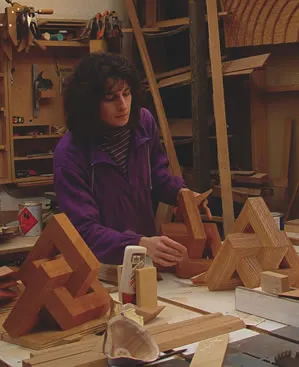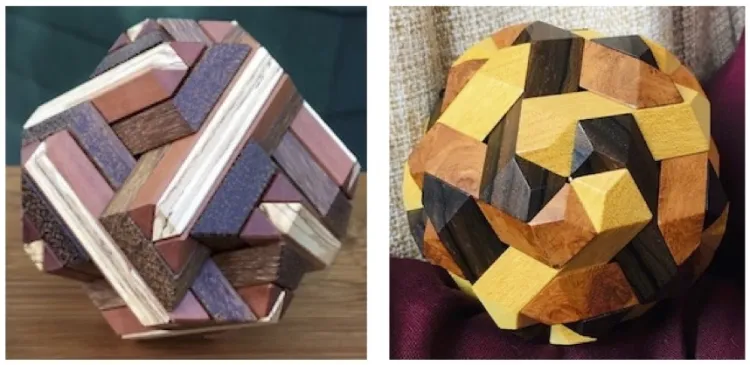Jane Kostick '88

Custom Woodworker
The following article is reprinted from article written by Andrea Hammer in the June 2004 issue of the Swarthmore Bulletin.
I pursued this line of work straight out of College because woodworking had always been something I enjoyed," Jane Kostick said. "In junior high and high school, I loved my woodshop classes, and then during my senior year at Swarthmore, I loved the woodshop that I used in my sculpture course with Professor [of Studio Art] Brian Meunier. I majored in math at Swarthmore, and the independent research I did for my senior paper was about tiling patterns, which, for me, was about two-dimensional art. That's when I first learned about the work of M.C. Escher."
Kostick now sees herself as a math artist who creates furniture, cabinetry, and puzzles. She particularly relishes creating wooden objects that "people can play with" and gifts such as multidimensional jewelry boxes.
"This interest in art and mathematics has led to so much in my life today. In 1992, [Albert and Edna Pownall Buffington Professor of Mathematics] Gene Klotz notified me about an art and mathematics conference at State University of New York-Albany. There, I met people from all over the world with this common math/art interest."
At this conference, Kostick was particularly inspired by and learned from Professor Koos Verhoeff of Holland, who knew Escher from decades earlier. "We went on to do some collaborative work, and I began learning about polyhedrons and spatial lattices, three-dimensional art," she said.
"I'm particularly grateful to have met the late Professor Arthur Loeb of Harvard's Design Science Department," Kostick added. He ran a lecture series at Harvard called the Philomorphs. It was at one of those lectures the following year that I met my husband, John, who shares this interest in geometry and also happens to work as a carpenter."
After an informal apprenticeship with a fine furniture maker in Cambridge for a year, Kostick rented space in a Boston woodshop to design and build her own furniture and artwork in wood.
"I sold work through art galleries in the beginning, and I still do occasionally," she said, "but I've always found it to be an unreliable way to make money. For several years, I worked other part-time jobs to pay bills. I earned enough to keep doing what I love, and gradually I acquired enough tools and machinery to set up my own woodshop, which is in a Tufts-owned industrial building in Medford. Most of the renters in the building are also woodworkers, so there are a lot of skilled people around to learn from."
A self-employed woodworker for 14 years, Kostick said, "The biggest challenge was how to make the artwork be profitable." To achieve that goal, she expanded her business into other types of woodworking besides mathematical art.
"This was a natural result of my husband being in the residential remodeling business. So I learned how to design and build custom cabinetry, which there seems to be an endless demand for in this area. That's about half of my business now. I still do the geometric woodworking, and I enjoy it more when there's no pressure to make money doing it," she said.
Kostick thinks that self-discipline is critical for self-employed workers. In her 20s, she learned to live on a small income-not needing much to maintain her lifestyle.
"The most gratifying thing about my work is that it balances with the rest of my life. For the most part, woodworking is solitary and peaceful, just the kind of energy I need in my life so I can take care of what's most important to me, which is my family. John and I have two sons, and being self-employed has enabled me to have a flexible schedule. I didn't plan it this way, but it couldn't have worked out better."




